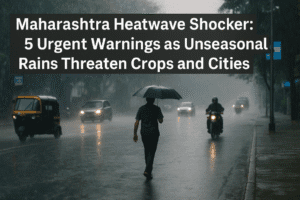Maharashtra Heatwave Shocker: 5 Urgent Warnings as Unseasonal Rains Threaten Crops and Cities
Amid a brutal heatwave pushing temperatures above 43°C in cities like Solapur and Akola, Maharashtra faces an unexpected twist: unseasonal rainfall from May 3–7, 2025, triggered by a western disturbance. The IMD’s yellow alerts predict thunderstorms and light-to-moderate showers across Nagpur, Pune, Mumbai’s outskirts, and Marathwada, offering fleeting respite but raising concerns for farmers mid-harvest. While the rains may briefly ease air pollution and heat stress, they risk damaging rabi crops like wheat and disrupting daily life with waterlogging in urban areas.
Experts link the anomaly to shifting climate patterns, warning of blurred seasonal boundaries. Authorities urge citizens to balance heat precautions—avoiding peak sun hours—with rain readiness, emphasizing real-time weather updates. This duality of scorching days and sudden showers underscores Maharashtra’s growing climate vulnerabilities, demanding adaptive strategies for agriculture and infrastructure.

Maharashtra Heatwave Shocker: 5 Urgent Warnings as Unseasonal Rains Threaten Crops and Cities
As Maharashtra grapples with a relentless heatwave, the India Meteorological Department (IMD) has thrown a curveball: unseasonal rainfall is set to drench the state from May 3 to May 7, 2025. This unexpected shift—triggered by a western disturbance sweeping southward from northern India—offers fleeting relief but also raises questions about its impact on agriculture, daily life, and the looming monsoon season.
The Weather Whiplash: Heatwave vs. Rain Alerts
While central Maharashtra and Vidarbha endure scorching temperatures above 40°C (with Akola, Solapur, and Jalgaon hitting 43–45°C), IMD’s yellow alerts signal a dramatic pivot. The rain, though sporadic, will blanket districts in phases:
- May 3–4: Nagpur, Amravati, Nashik, Pune, and Mumbai’s outskirts face thunderstorms.
- May 5: Statewide light-to-moderate rain, with thunderstorms likely.
- May 6–7: Konkan, Marathwada, and northern Maharashtra see continued showers, while Vidarbha dries up.
This clash of extremes—sweltering heat and sudden rain—has left residents perplexed. Streets in cities like Solapur, deserted during peak afternoon hours, may soon echo with the patter of unseasonal rain.
Why Is This Happening?
Western disturbances, typically associated with winter rains in north India, have shifted trajectory. “This system is pulling moisture from the Arabian Sea, causing convective clouds over Maharashtra,” explains Dr. Anupam Kashyapi, a Pune-based meteorologist. “While it’s rare for May, climate variability is making such events more frequent.”
Agricultural Anxiety
Farmers face a dilemma. The heatwave has already stressed rabi crops like wheat and pulses, and untimely rain could damage harvests. “We were preparing to cut the wheat crop, but rain now could ruin it,” says Vijay Mohite, a farmer in Ahmednagar. The state agriculture department urges farmers to monitor forecasts and delay harvesting where possible.
Urban Challenges
For cities, dust settling from rain may briefly improve air quality, but waterlogging in poorly drained areas like Mumbai’s suburbs could disrupt traffic. Meanwhile, power grids remain strained as air conditioning use continues amid humid post-rain weather.
Expert Insights: A Preview of Monsoon Trends?
While IMD clarifies this rain is not a monsoon precursor, some experts see a link. “Warmer oceans and shifting pressure systems are blurring seasonal boundaries,” says climatologist Dr. Roxy Mathew Koll. “This could hint at a longer monsoon period, but we need more data.”
Citizen Advisory: Navigating Dual Extremes
- Heat Safety: Avoid 12 PM–4 PM outdoor exposure; hydrate frequently.
- Rain Readiness: Secure loose objects, avoid flooded underpasses, and check IMD’s app (Mausam) for real-time alerts.
- Health Watch: Humidity post-rain may exacerbate heat-related illnesses.
The Bigger Picture
This weather anomaly underscores Maharashtra’s vulnerability to climate shifts. As the state juggles drought-like heat and unseasonal rain, adaptive infrastructure and updated farming practices grow urgent. For now, citizens are urged to stay alert—umbrellas and water bottles equally indispensable.
You must be logged in to post a comment.